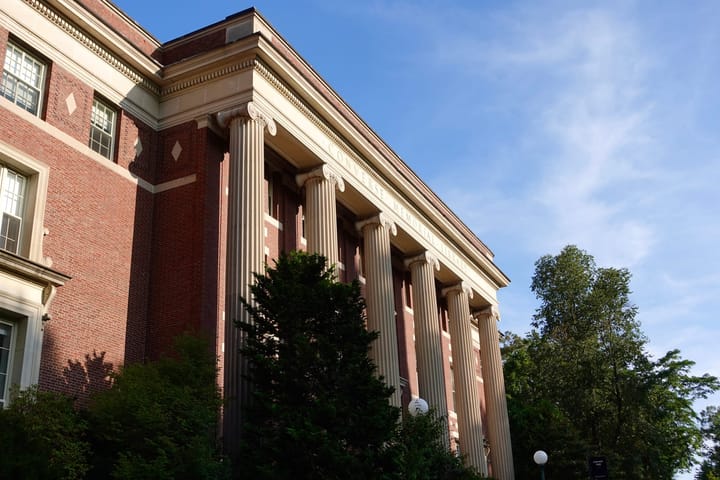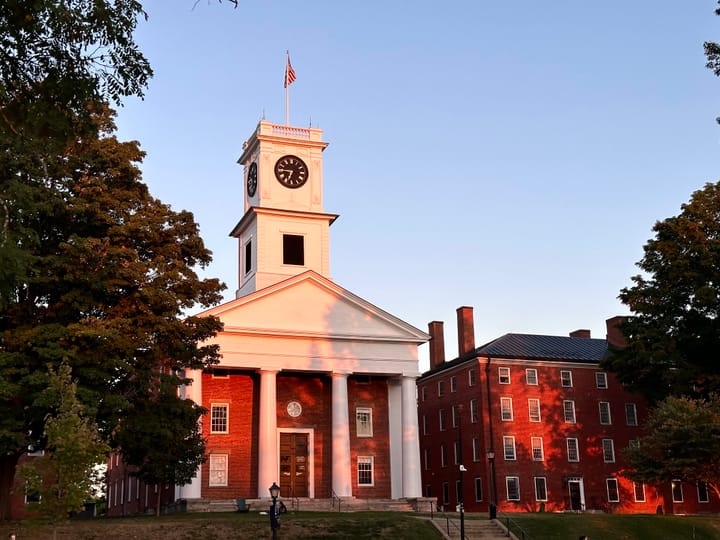What’s Between the First Ghost and Last Human Worker?
Contributing Writer Lucas Silva ’28 explores the tensions between artificial intelligence and memory, imagination, and creation, exposing its dangerous impacts on how we interact with our real world.
In 1962, Hanna-Barbera Productions introduced America to “The Jetsons,” a futuristic animated sitcom about a space-age family. In the first episode, Jane, the wife, overwhelmed with the pressures of work and home, is advised to purchase a robotic maid to handle household chores. Scenes later, she browses different options at the conveniently named “U-Rent-A-Maid” store.
Ultimately, bringing home an XB-500 model, the Jetsons simultaneously welcomed Rosie the Robot, an indispensable contribution to the family, and a paradox. She is solely built to mop floors and serve drinks, yet she blushes, sulks, cries, and even falls in love like a human would. Rosie is, at once, a machine and a family member.
Though all the possible robot maids in “The Jetsons” varied in cost, language, and technical elaborateness, they all shared one unmistakable feature: Each reproduced the same cultural archetype of the mid-century maid, coded as female, deferential, and domestic.
Today, as artificial intelligence creeps into roles once held by humans, it leaves behind more “Rosies.” Banks shift to self-service kiosks, trucks now move under autopilot, and offices depend on digital assistants. Yet, when the workers vanish, their images do not. Our imagination preserves their ghosts, the human who was the teller, the driver, the secretary.
These ghosts are the afterlife of labor, the imprint of bodies and roles once visible in daily life. They are ghosts, because they’re not simply remembered but powerful precisely because of partiality: half-forgotten, half-invented, suspended between history and imagination.
Therefore, human imagination may risk stagnation without human workers to challenge stereotypes, as algorithms recycle old images and use old data.
Imagination
Imagination, in many ways, is the condition of how we capture the world. In “The Rule of Metaphor” (1975), philosopher Paul Ricoeur argued that cultural imagination is always double: reproductive and productive at once. To be reproductive is to repeat inhabited images that precede us (figures, stereotypes, and symbols of our intuitions). To be productive is to schematize, dismantle established semantic networks, generate new pertinence out of institutions, and reconfigure images into something unforeseen. To productively imagine then is to see something “as” something else without reducing it to sameness.
For example, Ricoeur would argue that when we say “time is a river,” we do not confuse the two terms; rather, we place them in a productive tension. Time takes on the qualities of flow and irreversibility, while the river acquires transience. Each term is refigured in light of the other. What matters here is not analogy in the strict sense but by presenting similarity-in-difference, a resemblance that is not reducible to logical identity. It is here, in this work, that imagination shows itself as productive rather than merely reproductive, where the force to see the world otherwise bears witness to the very site of new meaning.
Imagination works as an incentive to reconfigure reality. It creates a causal chain between reproduction and production, where old images demand repetition, yet simultaneously invite something new. This is where ghosts are most active: memories of who and what once was linger, but they can be re-cast into new life. The choice is never automatic; the cultural-cognitive labor of imagination decides whether resemblance hardens into tradition or opens onto something new thereafter.
Because imagination always begins with what culture gives us (reproduction), its creative power depends on how those materials are used for production. Ideally, imagination is continually refreshed with new metaphors that expand who and what we can picture. But what happens when this process fails, and imagination becomes trapped in recycling the same old images, the same ghosts, again and again?
Memory
Collective memory, too, is an act of imagination, but backwards. Through memory, we romanticize, omit, store, or change, often through nostalgia or distortion. For Ricoeur, memory operates much like reproductive imagination. It recalls images that continue to influence the present. Yet memory also supplies the material for productive imagination. When we build new technologies, we often lean on remembered images to imagine what is possible. But here lies the tension: when technological change accelerates faster than our ability to reconfigure those past images, imagination risks being overrun by its reproductive side. This is what sociologist William Ogburn called “cultural lag” — the delay by which our beliefs, values, and norms fail to keep pace with material innovations (“Social Change with Respect to Culture and Original Nature,” 1922).
When a new invention arrives, we continue thinking in old ways for a while. The automobile, for example, did not erase the image of the carriage; engines are still measured in “horsepower,” a ghostly reminder of the horse as the original unit of labor. The persistence of past images in our language and imagination creates a cultural lag, leaving us attached to outdated visions of work and workers even as machines reshape reality.
Imagine an occupation historically done by a marginalized group — say, migrant farm laborers, telephone operators, or domestic cleaners. If robots or algorithms take over these jobs, the actual workers vanish from sight, yet their image may linger in public memory, frozen at the moment of exit. With no new human examples to update the category, the last known profile becomes the default mental image in the collective imagination. Society might subconsciously “remember” that farm work is for immigrants, and cleaning is for people of the lower social class. As for telephone operators, who were traditionally women, consider why Siri, Alexa, and ChatGPT default to a female voice.
There might be a real risk that automation can pause the evolutionary update of our stereotypes. Memory becomes a dated, oddly authoritative museum exhibit because nothing can replace it. Cultural lag also means we may overlook the need to change our thinking. If AI smoothly takes over a job and is marketed as progress, we might celebrate convenience while ignoring the humans who once performed the work.
The classed, racialized, and gendered associations to these jobs will ossify because there’s no ongoing human presence to challenge stereotypes with lived reality. It’s not necessarily on the premise that these marginalized groups can’t pursue other jobs; it’s that now they’ll take the unresolved prejudice to the grave.
Here, reproduction overwhelms production. Automation halts the possibility of productive imagination by removing the very presence that might have unsettled it. Left to itself, memory can turn them into museum pieces, authoritative because they are old, unquestioned, and familiar.
In such circumstances, memory ceases to be a resource and becomes a prison, locking society into prejudices that appear natural only because they are traditional. If there’s no challenge, reproduction feeds into reproduction.
Automation and Representation
Now consider AI-driven content, from image generators to recommendation algorithms. These systems are trained on existing data, which means they often serve as mirrors tilted toward the past. They operate solely on the side of reproductive imagination.
In effect, the algorithm takes the single story society has told about specific jobs and projects it in vivid color, ad infinitum. Such algorithmic representations can be even more insidious than traditional media because they feel objective. A search result carries a computational authority (“this is just what comes up”), yet behind that neutrality lies a circular logic: the machine feeds cultural imagination back to itself. If our collective memory envisions a software engineer as Asian, the AI will reproduce him endlessly, excluding the possibility of a different figure ever becoming visible.
The result is a doubly ironic loop: AI replaces the human role, and in doing so, perpetuates the image of the human who used to be in that role. The stereotype is preserved within the automation itself. All of these point to a profound cultural dilemma. Technological automation moves quickly, often too quickly for society to thoughtfully adapt. We implement the tool before we’ve reflected on the narrative. If cultural imagination fails to keep pace, we risk valuing the human touch only once it has nearly vanished — and then only in a sentimental, caricatured form.
A Call to Consciousness
The challenge is clear: We must not allow our minds to be automated along with our industries, especially with the unprecedented challenge of AI. As educated readers — especially students who will shape what comes next — we must keep the cultural imagination supple and critical. That means being actively attentive to what is remembered, what is projected, and what remains possible to imagine in an inescapable AI-driven society. Poetically enough, humans' most excellent power against crises is envisioning novelty.
This is resistance. The encroachment of AI into the workforce need not spell the end of human dignity or diversity. To ensure it doesn’t, we must intervene in that space where culture meets technology: our imagination. We must not allow the last human to hold any job to become a permanent cardboard cutout in our minds. The future demands that we become curators of our collective imagination. Each of us, especially the young and inquisitive, must keep alive the question: what more might this role, this person, this society become, if we only dare to imagine otherwise?





Comments ()